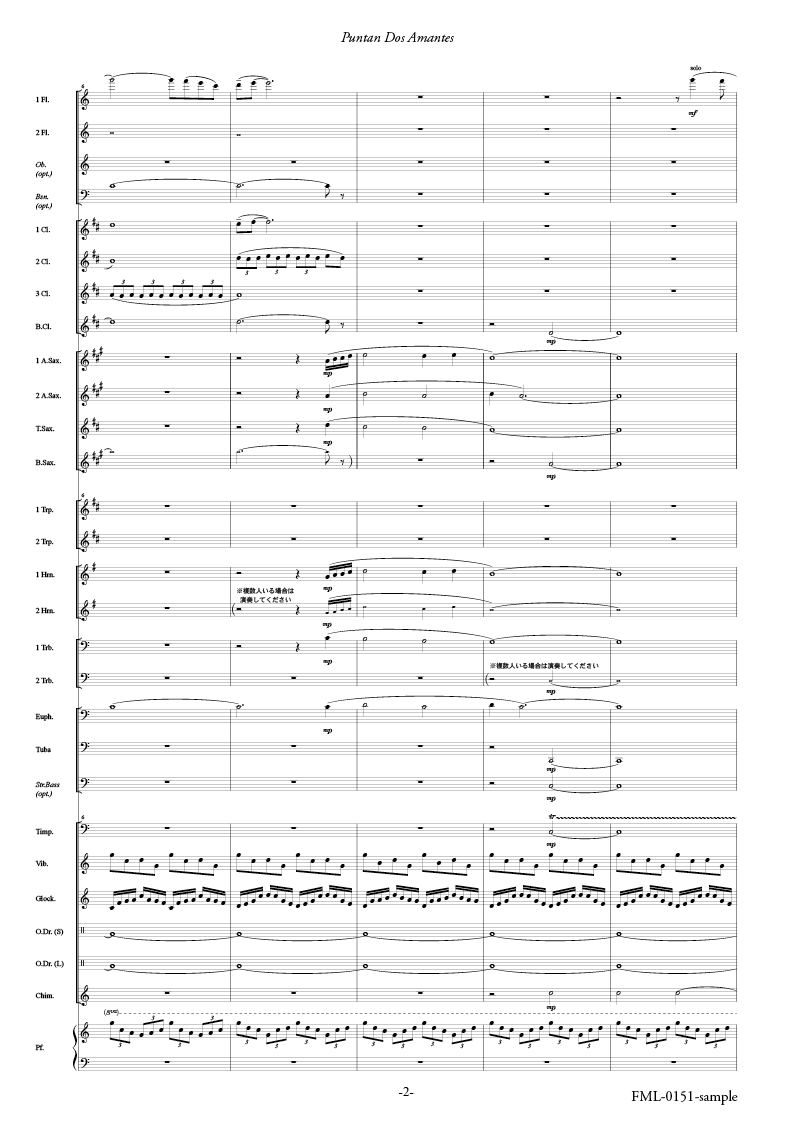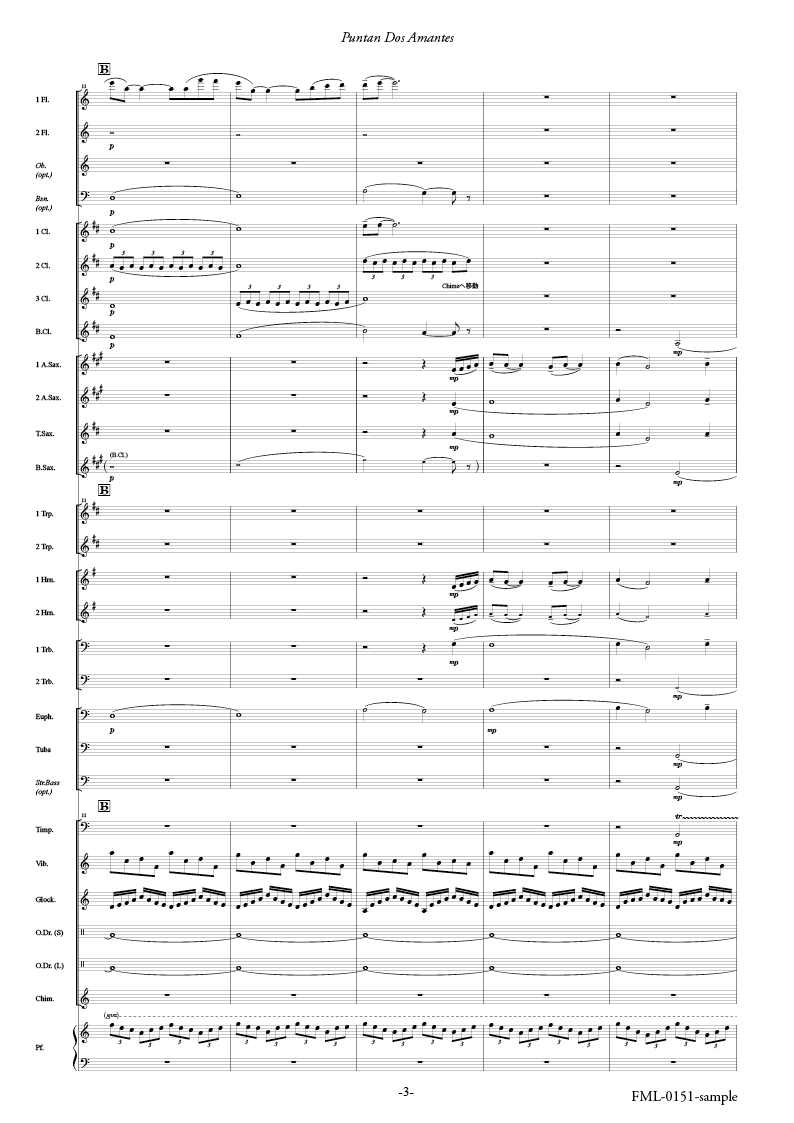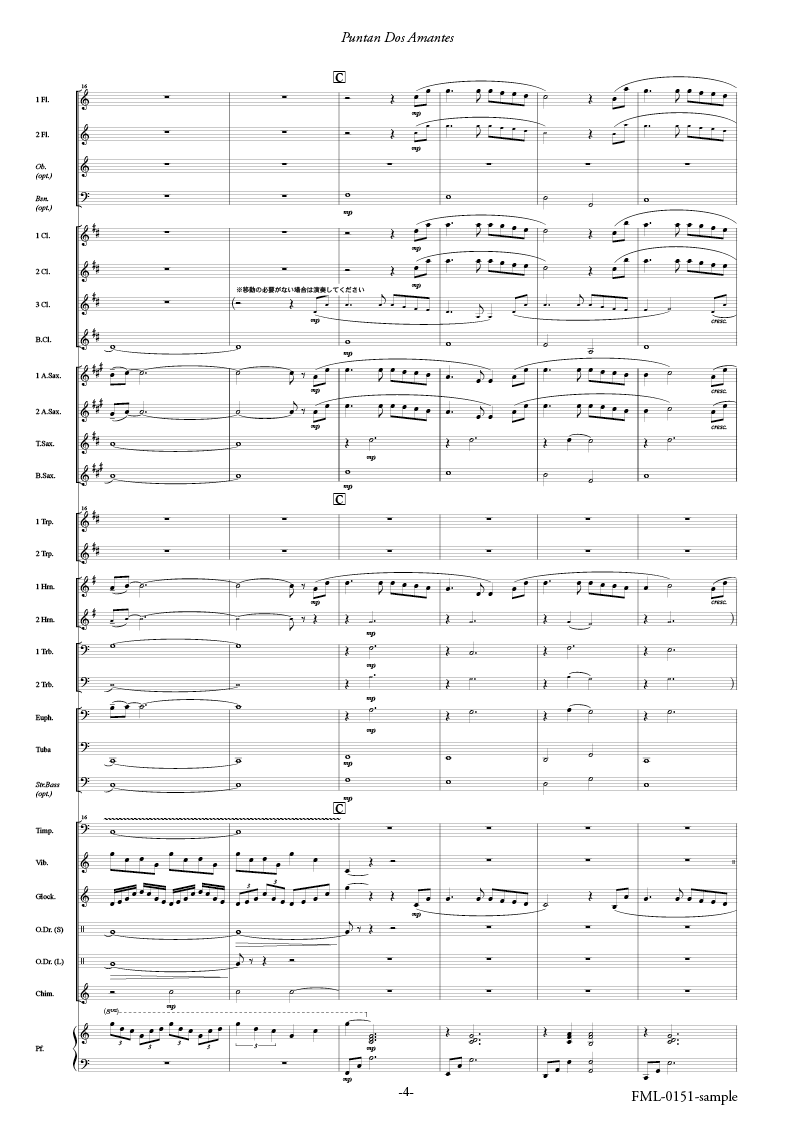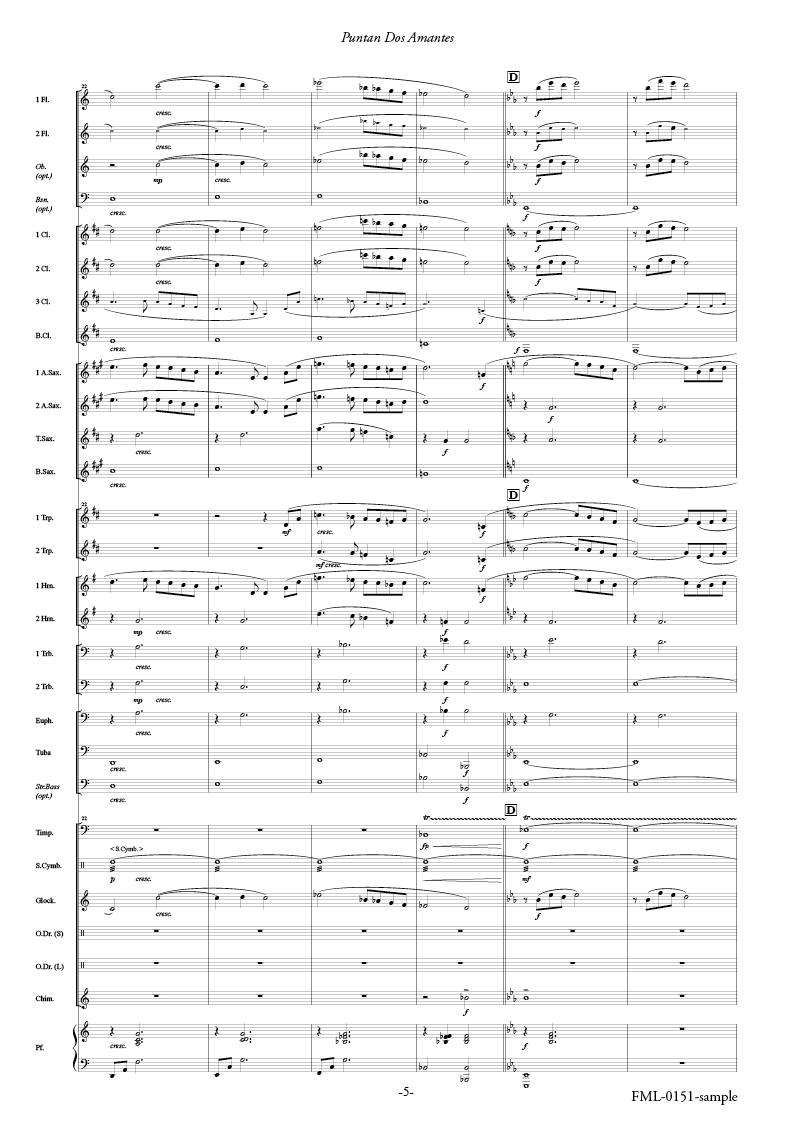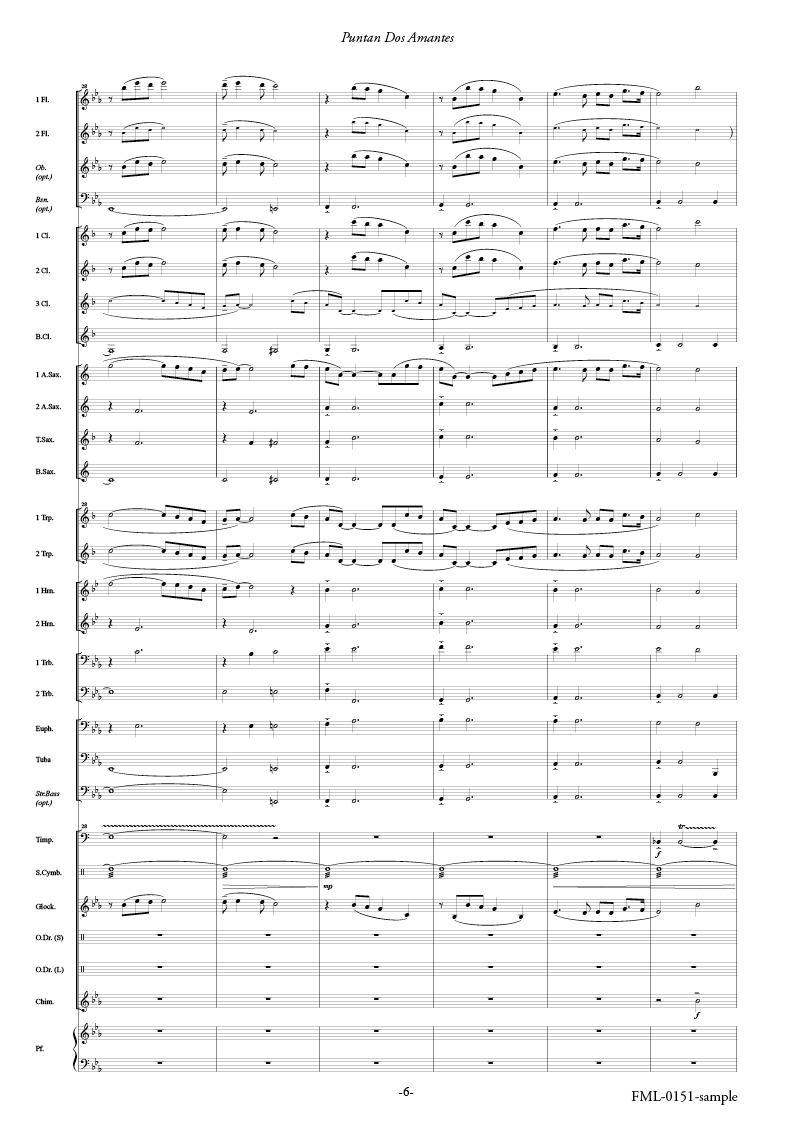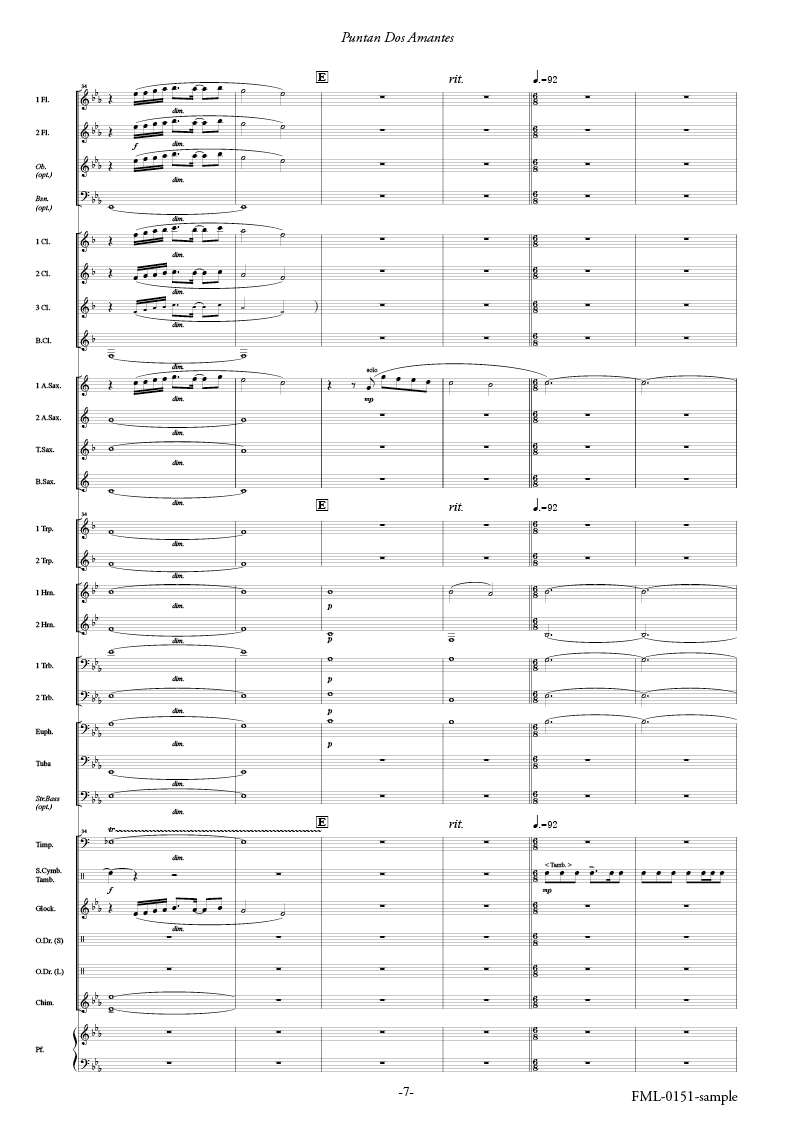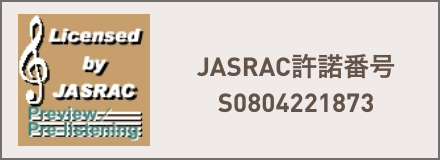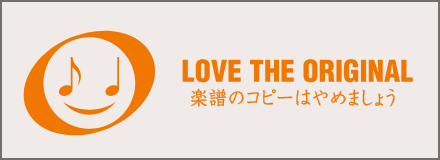プンタン・ドス・アマンテス:加藤大輝 [吹奏楽スコア]
・1配送につき税込11,000円以上のご注文で国内送料無料
・コンビニ後払い、クレジットカード、銀行振込利用可
・[在庫あり]は営業日正午までのご注文で即日出荷
・International Shipping
- 概要
- 編成/曲目
- 補足
- ENGLISH
プンタン・ドス・アマンテス
Puntan Dos Amantes(プンタン・ドス・アマンテス)とは、グアムのタモン湾の北端にある岬で、「恋人岬」とも呼ばれます。
グアムのスペイン統治時代に、チャモロ(マリアナ諸島の先住民)の美しい娘が、結婚を迫るスペイン人総督から逃れ、同族の恋人と永遠の愛を誓い、髪を結びあって岬から身を投げた、という悲恋伝説から、この名が付けられました。
冒頭、フルートのソロによって提示されるのが娘のテーマ、途中テンポの落ち着いた部分でテナーサクソフォンのソロによって提示されるのが恋人のテーマです。全編にわたって、この2つのテーマが様々な形で現れます。一番の聴かせどころ[T]では、2つのテーマが同時に再現されます。
時系列にそって物語を綴るというよりは、より抽象的な感情をイメージして作曲をしました。演奏の際には、核となる2つのテーマを追うことで、音楽の進む方向が明確になるかと思います。
小編成でも打楽器の音色のパレットが最大限に使えるよう、加養浩幸氏のアイディアにより管楽器奏者による打楽器持ち替えがあります。打楽器を下手(客席から見て左側)にまとめてセッティングする際は、テナーサクソフォン・ユーフォニアム奏者が持ち替えるPerc.5のパートを上手にセッティングされると、より効果的です。
●小編成バンドへのメッセージ
小編成バンドには、大編成とは違った魅力、やりがい、難しさがあると思います。
私が中学時代に所属していた吹奏楽部は、先輩が10人しかいない小編成バンドでした。一人でも欠けると成り立たない難しさがありましたが、一人ひとりが意思を持って演奏できたときの一体感は、大人になった今振り返っても、決して大編成バンドのそれに劣るものではありませんでした。
演奏上の注意していただきたい点は、各楽器のブレンドです。赤と青をどれくらいの比率で混ぜるかによって、いろいろな紫が作れるように、例えばサクソフォンとホルンのユニゾンも、ブレンドの具合によって様々な音色が作れます。まずは楽譜通りの強弱を表現することが大切ですが、その先のブレンドを工夫することによって、色彩豊かな演奏が可能だと思います。(加藤大輝)
仕様
- アーティスト
- 作曲: 加藤大輝
- 演奏形態
- 吹奏楽
- 編成
- 小編成 / 20 - 28パート
- 演奏時間
- 0:07:30
- グレード
- 3
- 商品カテゴリ
- スコア
- 出版社 / 品番
- フォスターミュージック / FML-0151FS
- JANコード
- 4560318472860
- 発売日(年)
- 2020/05/21
- 【レンタル譜】プンタン・ドス・アマンテス:加藤大輝 [吹奏楽小編成]
スタディスコア/セット・版違いなど
楽器編成
- Flute 1
- Flute 2
- Oboe (optional)
- Bassoon (optional)
- Bb Clarinet 1
- Bb Clarinet 2
- Bb Clarinet 3
- Bass Clarinet**
- Alto Saxophone 1
- Alto Saxophone 2
- Tenor Saxophone
- Baritone Saxophone (optional)**
- Trumpet 1
- Trumpet 2
- Horn 1
- Horn 2
- Trombone 1
- Trombone 2
- Euphonium
- Tuba
- String Bass (optional)
- Piano (optional)***
- Timpani
- Percussion 1 (Vibraphone, Suspended Cymbal, Tambourine, Wind Chime, Snare Drum, 3 Toms)
- Percussion 2 (Glockenspiel, Bass Drum, Crush Cymbals, Suspended Cymbal)
- Percussion 3 (Ocean Drum (small), Bass Drum) (optional)***
- Percussion 4 (Ocean Drum (large), Field Drum, Suspended Cymbal) (optional)***
- Percussion 5 (Chimes, Glockenspiel) (optional)***
加藤大輝(Daiki Kato)
岐阜県大垣市生まれ、埼玉県新座市在住。幼少の頃よりピアノ・作曲を、中学より各種管楽器を広く浅く経験。18歳より打楽器を始める。
打楽器奏者として、主にマリンバを中心とした打楽器アンサンブルでの演奏を小中学校・福祉施設・カフェ等で行う他、中高生向けの吹奏楽・アンサンブル作品を多数作曲しており出版もされている。また近年では、特異な経歴を生かし吹奏楽指導も行っている。
尚美コンセルヴァトアールディプロマ科(打楽器専攻)修了。第22回KOBE国際音楽コンクール奨励賞。第3回日本管打・吹奏楽学会作曲賞佳作。グアム・タモンベイ音楽祭へ3年連続で委嘱作品を書き下ろし、感謝状を授与される。
これまでに打楽器・マリンバを、小川佳津子、百瀬和紀、日比一宏の各氏に、作曲を、鈴木英史、広瀬勇人、高橋伸哉、武野晴久の各氏に師事。
Percussion Ensemble “Beat Laboratory”主宰。Ensemble Variusメンバー。neoria KOROGIアーティスト。電子マリンバ「malletKAT」エンドーサー。
- サイズ
- A4/1cm未満
PUNTAN DOS AMANTES:Composer: Daiki KATO
Puntan Dos Amantes is a cape at the northern edge of Tumon Bay in Guam, and is also known as the “Lovers’ Cape.”
The cape was given this name because of a legend from the Spanish colonial era of Guam which recounts the tragic love story of the beautiful daughter of an indigenous Chamorro man living on the Mariana Islands. She had fled from a Spanish captain who was trying to force their marriage and met with her Chamorro lover. The lovers then swore their eternal love for each other, bound their hair together, and threw themselves off the cliff.
The opening of this piece features a theme inspired by the lady that is carried by the flute solo, with her lover’s theme carried by the tenor saxophone solo in the following section marked by a slower tempo. After emerging in a number of variations throughout the entire piece, the two themes are recapitulated simultaneously in a section that is the highlight of the piece.
Instead of presenting a chronological narrative of the stories, I have written the piece by attempting to capture more abstract emotions. When performing the piece, placing an emphasis on foregrounding the two central themes will give the music a stronger sense of direction.
In order to maximize the tonal palette of the percussion section in small ensembles, I have adopted an idea of Kayo Hiroyuki where performers on wind instruments take over percussion instruments. In the event that the percussion section is concentrated on the left side of the stage, it will be more effective for the Percussion 5 part performed by those on the tenor saxophone and euphonium to be assigned to the right side of the stage.
Specifications
- ARTIST
- Composer: Daiki KATO
- INSTRUMENTATION
- Windband / 16-25 Players
- DURATION
- 0:07:30
- GRADE
- 3
- PRODUCT TYPE
- STUDY SCORE (PARTS Sold separately)
- PUBLISHER / Code
- fostermusic Inc. / FML-0151FS
- JAN
- 4560318472860
- RELEASE
- 2020/05/21
- OVERSEAS SHIPMENT
- Yes
- EUROPEAN PARTS
- Not Included
For foreign customers,
You can now purchase from overseas via WorldShopping BIZ.
Study scores, ensembles, and CDs can be ordered directly from our website.
Rental sheet music and some other items are not covered by this cart system, so please contact us by email.
eia6yohmjx4c
〈12月〉会員限定クーポン(対象商品:フォスターミュージックの出版物)
対象カテゴリ
- 国内出版社 > フォスターミュージック
会員限定
¥1,000 OFF
残発行枚数:41
下限金額:¥5,500
有効期間:2025/12/01 ~ 2025/12/31

![プンタン・ドス・アマンテス:加藤大輝 [吹奏楽スコア]](/html/upload/save_image/FML0151_3.png)
